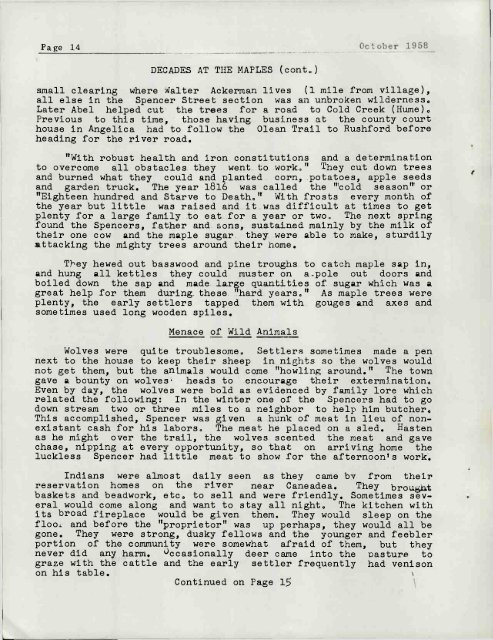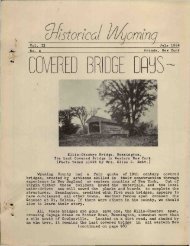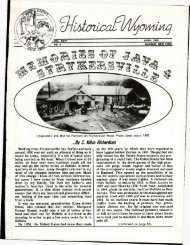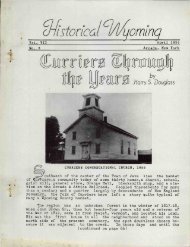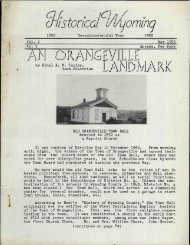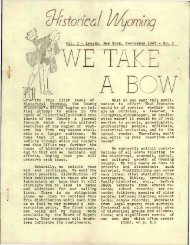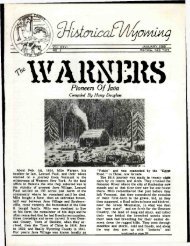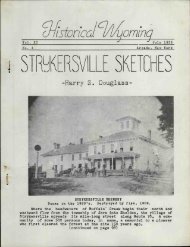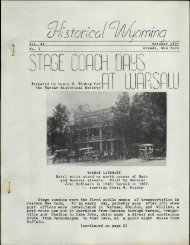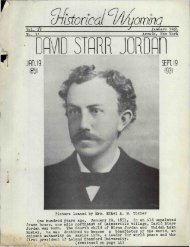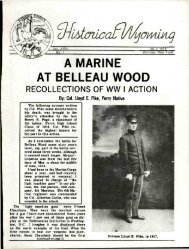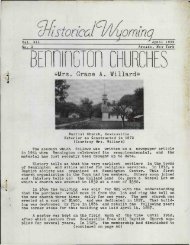Historical Wyoming County October 1958 - Old Fulton History
Historical Wyoming County October 1958 - Old Fulton History
Historical Wyoming County October 1958 - Old Fulton History
You also want an ePaper? Increase the reach of your titles
YUMPU automatically turns print PDFs into web optimized ePapers that Google loves.
Page 14<br />
DECADES AT THE MAPLES (contj<br />
small clearing where Walter Ackerman lives (1 mile from village),<br />
all else in the Spencer Street section was an unbroken wilderness,,<br />
Later Abel helped cut the trees for a road to Cold Creek (Hume)0<br />
Previous to this time, those having business at the county court<br />
house in Angelica had to follow the dean Trail to Rushford before<br />
heading for the river road.<br />
"With robust health and iron constitutions and a determination<br />
to overcome all obstacles they went to work.," '^hey cut down trees<br />
and burned what they could and planted corn, potatoes, apple seeds<br />
and garden truck. The year 1816 was called the "'cold season" 1 or<br />
"Eighteen hundred and Starve to Death." With frosts every month of<br />
the year but little was raised and it was difficult at times to get<br />
plenty for a large family to eat for a year or two- The next spring<br />
found the Spencers, father and sons, sustained. mainly by the milk of<br />
their one cow and the maple sugar, they were able to make, sturdily<br />
attacking the mighty trees around their home.<br />
They hewed out basswood and pine troughs, to catch maple sap in,<br />
and hung all kettles they could muster on a-pole out doors and<br />
boiled down the sap and made large quantities of. sugar which was a<br />
great help for them during- these "hard years." As maple trees were<br />
plenty, the early settlers tapped them with gouges and axes and<br />
sometimes used long wooden spiles.<br />
Menace of Wild Animals<br />
Wolves were quite troublesome. Settlers sometimes made a pen<br />
next to the house to keep their sheep in nights so the wolves would<br />
not get them, but the animals would come "howling around." The town<br />
gave a bounty on wolves 1 heads to encourage their exterminations<br />
Even by day, the wolves were bold as evidenced by family lore which<br />
related the following: In the winter one of the Spencers had to go<br />
down stream two or three miles to a neighbor to help him butcher.<br />
This accomplished, Spencer was given a hunk of meat in lieu of nonexistant<br />
cash for his labors. The meat he placed on a sled. Hasten<br />
as he might over the trail, the wolves scented the meat and gave<br />
chase, nipping at every opportunity, so that on arriving home the<br />
luckless Spencer had little meat to show for the afternoon's work.<br />
Indians were almost daily seen as they came bv from their<br />
reservation homes on the river near Caneadea. They brought<br />
baskets and beadwork, etc0 to sell and were friendly. Sometimes several<br />
would come along and want to stay all night* The kitchen with<br />
its broad fireplace would be given them. They would sleep on the<br />
flooi and before the "proprietor" was up perhaps, they would all be<br />
gone. They were strong, dusky fellows and the younger and feebler<br />
portion of the community were somewhat afraid of them, but they<br />
never did any harm. Occasionally deer came into the pasture to<br />
graze with the cattle and the early settler frequently had venison<br />
on his table. \<br />
Continued on Page 15


